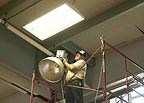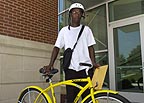August 01, 2006
SIUC looking high and low to trim energy costs
CARBONDALE, Ill. -- For three days in March, Justin Harrell, an electrical engineer at Southern Illinois University Carbondale, and two other SIUC employees traversed the dark, narrow tunnels housing steam pipes that snake beneath the campus supplying heat and power for cooling systems.
The group checked the function of dozens of steam traps, devices that help keep the critical steam lines open by giving air and condensed water a means to escape the system without interrupting the steam pressure. Malfunctioning traps can be a major drain on the system. Harrell's team found 30 such failed devices, along with some miscellaneous leaks and insulation deficiencies.
The cost of the repairs will pay for themselves in savings within two months, Harrell estimates, and the effort will save the University thousands of dollars annually.
"The savings are tremendous if you can find them and stop them, " said Harrell, whose main job at SIUC is finding ways to save money on utilities and maintenance,
As families and businesses everywhere scramble to save on energy costs amid skyrocketing prices, SIUC is no different. The University is well along on a coordinated, multi-year effort designed to cut such costs.
So far, SIUC has spent more than half of a $4 million loan it took out a few years ago aimed at making energy-saving upgrades. The idea is to recoup that amount and more through updated technology and other methods.
If the University saves money, the students save money.
"From a budget standpoint, the University has not received additional utility funding for a number of years but the rates continue to increase," said Catherine A. Hagler, executive director of administration at SIUC. "Utility costs make up about half of the Plant and Service Operations budget and student housing, the Student Center and the Recreation Center pay for their own utilities through fees. So anything we can do to help save energy costs is passed on to students through lower housing costs and fees."
The University spends up to $12 million a year on various utilities for major academic buildings and another $1.5 million for ancillary facilities such as the Student Center and Student Recreation Center.
And those numbers are rising. The price of coal, which SIUC uses for heating and cooling campus buildings and to generate about 15 percent of its annual electrical requirements, has risen some 30 percent during the last two years. Electricity costs are up 15 to 20 percent this year alone.
Phillip S. Gatton, director of Plant and Service Operations, said the University is employing several strategies to offset those increases. SIUC joined a coalition of state universities that are pooling their electricity volume to secure a better bulk rate from the power companies. On campus, workers installed almost $1 million worth of new, more efficient light fixtures and are taking steps to reduce gasoline usage by University vehicles, including utilizing bicycles for some campus deliveries.
Harrell, who also is working on his master's degree in electrical and mechanical engineering at SIUC, can tick off a list of projects –past, present and future – the University is pursuing in its quest to trim the bills. For instance:
• In Pulliam Hall gymnasium, workers are changing out 24, 400-watt metal halide lights with 24, six-lamp, 54-watt fluorescent fixtures. The new fixtures will not only cut power use by 38 percent, but also improve the quality of the light. Infrared occupancy sensors trigger the new lights, which turn on only when people are present. Previously, the lights were left on for long periods of time because the old fixtures took some time to warm up before working. Harrell estimates the occupancy sensors will cut light burn time by half.
• Workers installed occupancy sensors in many restrooms and hallways throughout several buildings. They also put in light sensors in some areas, which constantly monitor the amount of light in a given area and turn light on only if it falls below the standard for that type of room use.
• Lawson Hall will be equipped with new controls for its air handling system, which can control the speed of fans based on pressure readings inside ducts and thermostat readings.
• Harrell is conducting a major study of the centrifugal chillers used to cool buildings around campus, searching for peak efficiencies and other opportunities to save energy.
Harrell is planning a study of gasoline use by campus vehicles in the near future. In the meantime, however, officials continue making the University's vehicle fleet "greener" by utilizing ethanol-burning and hybrid gas-electric vehicles and matching tasks with vehicles to ensure efficiency, said Brad Dillard, associate director of Plant and Service Operations. With gas prices rising, officials also trained a few student workers to deliver packages using bicycles instead of vehicles.
Workers also are installing additional instrumentation throughout the campus that will give officials a clearer picture of the amount of power used in specific areas. The real-time data is crucial to the conservation effort, Gatton said.
"You can't save it if you don't know how you're using it in the first place," Gatton said. "We're trying to identify how much power is used in each building so we can tell when the peaks are for each one, and then we're trying to shave down those peaks.
"As a group, if all our peaks are minimized, that will make us a more attractive customer to the utility companies," he said, which means the University will get a better price.
Newer buildings, such as the Student Health Center and the Troutt-Wittmann Athletic and Training Center, were equipped with such monitoring equipment, Harrell said. Recent renovations, such as Altgeld Hall and the ongoing Morris Library project, will include such provisions as well.
Workers also are installing new electric meters in buildings that previously shared a meter with other facilities, Gatton said. Plans also call for more instrumentation to monitor steam and chill water flow, which heats and cools buildings.
"Basically, we're becoming smarter about doing a better job managing our resources," Gatton said. "We can look at that data and see where to make good investments in new equipment. We look at payback. Our goal is to install equipment that will pay for itself in two to five years."
Other efforts include changing roof colors to white to reflect heat and increasing insulation in key areas, Gatton said. He's also trying to spread the word throughout campus that individual employees also can make a difference.
"We're asking people to do things like turn off the lights if they don't need to be on," Gatton said. "We need everyone to buy into the fact the University has to pay for energy and there isn't an unlimited resource out there to pay the bills."
Cultivating a mindset of continuous improvement, while using existing resources wisely, is among the goals of Southern at 150: Building Excellence Through Commitment, the blueprint the University is following as it approaches its 150th anniversary in 2019.

Making some changes – Lonnie
Barnes, an electrician with
Plant and Service Operations
at Southern Illinois University
Carbondale, is replacing the
old metal halide lights he is
holding with new T-5 fluorescent
energy-saving lights, such as
the one mounted on the ceiling
above him, in the gymnasium at
Pulliam Hall on the SIUC campus.
The lighting changes are part of
an ongoing $4 million campaign to
reduce energy costs on the SIUC
campus. Download Photo Here

Pedal power – Joe Ferrell,
19, a sophomore from Carbondale
at Southern Illinois University
Carbondale, poses with a bicycle
he uses to deliver parcels for
the SIUC Transit Service on
campus under a new program
aimed at saving energy expenses.
Download Photo Here
